Off Grid Living: A Complete Guide for Beginners
Embark on a self-sufficient life! Discover essential tips & tricks for beginners in our ultimate guide to off-grid living and start your off grid living journey with confidence
Do you wish you could live a simpler, more self-sufficient life? Do you want to ditch the public utilities and rely on your own sources of power, water, and waste management? If you do, you might want to give off grid living a try. Imagine a life where you cut down your environmental impact, save some money, and enjoy more freedom and flexibility? If you do, you might be interested in off grid living. It is a lifestyle choice that is quickly gaining interest world-wide and for good reason!
Table of Contents
We've been off grid living since 2015
Here’s how it started…
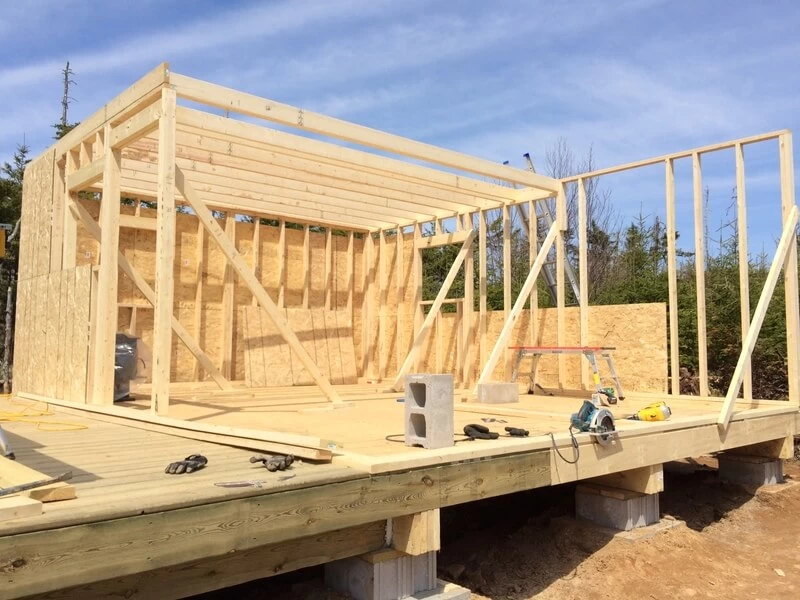
… and how its going.
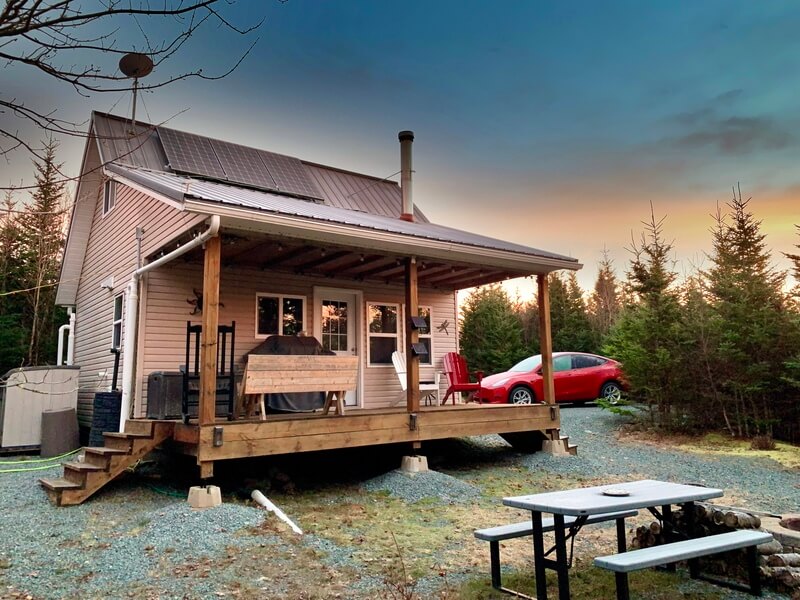
An Introduction to Off Grid Living
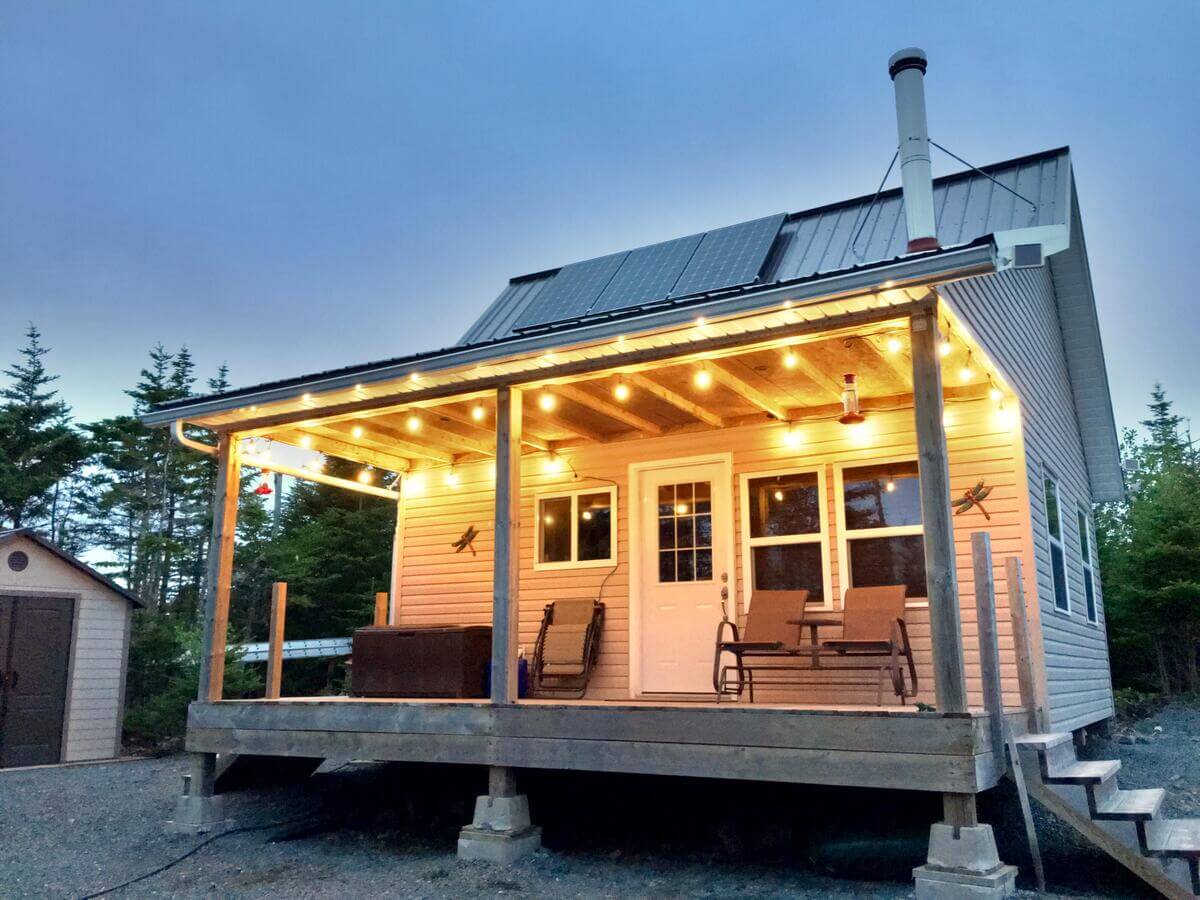
Off grid living is a lifestyle choice that means living without relying on public utilities like electricity, water, gas, or sewerage. Instead, you use alternative sources for power, water, and waste management, like solar panels, rain barrels, compost toilets, and generators.
For example, you can use solar panels to capture the sun’s energy and batteries to store it for later use. You can use rain barrels to collect water and filter it for drinking, cooking, and cleaning. You can use compost toilets to turn your human waste into soil, propane tankless water heaters for hot water and a propane heater as a primary/secondary backup heating source to keep you warm. And for those times when you really need it, you can use a small gas generator to power up your devices. Sounds pretty cool, right?
People choose off grid living for different reasons, like self-reliance, cost savings, environmental concerns, or personal preference. Off grid living can also vary in degree, from completely disconnected to partially connected to the grid.
Some people might envision off grid living as remote a life as living in a hand built Alaskan log cabin. And there’s nothing wrong with it if that’s the way you want to go. Richard Proenneke did it for thirty years. In fact, we wrote a complete story called “How Dick Proenneke built a log cabin alone in Alaska”.
At the other end of the spectrum, you can have an off grid home stuffed to the rafters with the latest technology that is completely automated and rivals the comforts of even the fanciest on grid home.
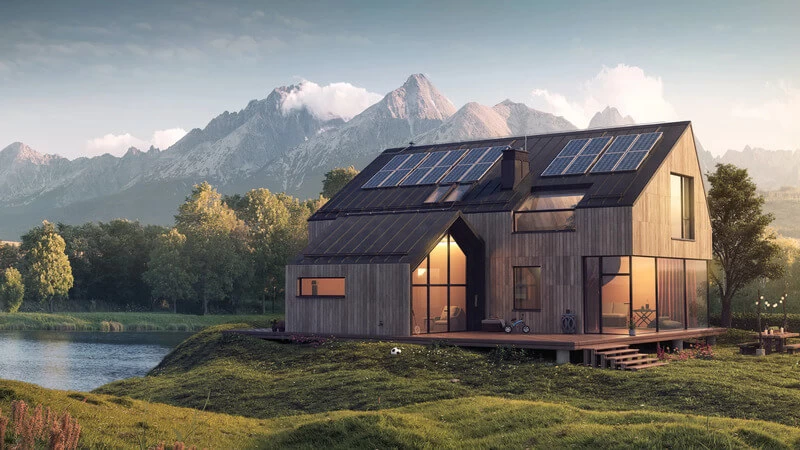
In this article, we’ll give you a complete guide for beginners who want to learn more about the basics of off grid living.
We’ll cover four broad but common topics we get asked the most:
- How to Power Your Off Grid Home
- How to Get Water for Your Off Grid Home
- How to Manage Waste for Your Off Grid Home
- How to Stay Connected and Secure in Your Off Grid Home
By the end of this article, you’ll have a much better understanding of what off grid living involves, and how you can start your own off grid journey. In today’s day and age, it’s probably not what you may have envisioned and that’s probably a good thing.
The topic of designing, building, finding land or buying an existing off grid home each has its own article on our website. So in this article let’s pretend you just bought or finished building your off grid home and let’s answer the four most common questions we get asked about off grid living.
Let’s get started!
How to Power Your Off Grid Home
One of the most important things about off grid living is how to power your off grid home. Without electricity, you can’t run your appliances, lights, heating, cooling, and other devices that make your life comfortable and convenient.
Luckily, there are many options for generating your own electricity from renewable sources, like solar, wind, hydro, and biomass. These sources are clean, green, and abundant, and can help you reduce your carbon footprint and utility bills. We have created a complete beginners guide to off-grid solar systems.
But, choosing the best system for your off grid home can be tricky, as there are many things to think about, like your location, climate, energy needs, budget, and preferences. Here are some of the common types of renewable energy systems for off grid homes, and how to use them safely and efficiently:
Solar Power
Solar power is one of the most popular and widely available sources of renewable energy for off grid homes. Solar power works by turning sunlight into electricity using photovoltaic (PV) panels. Solar power is great for sunny and warm climates, and can provide enough power for most of your daily needs. But, solar power also has some downsides, like the high initial cost, the need for batteries and inverters, the dependence on weather and daylight, and the maintenance and cleaning of the panels.
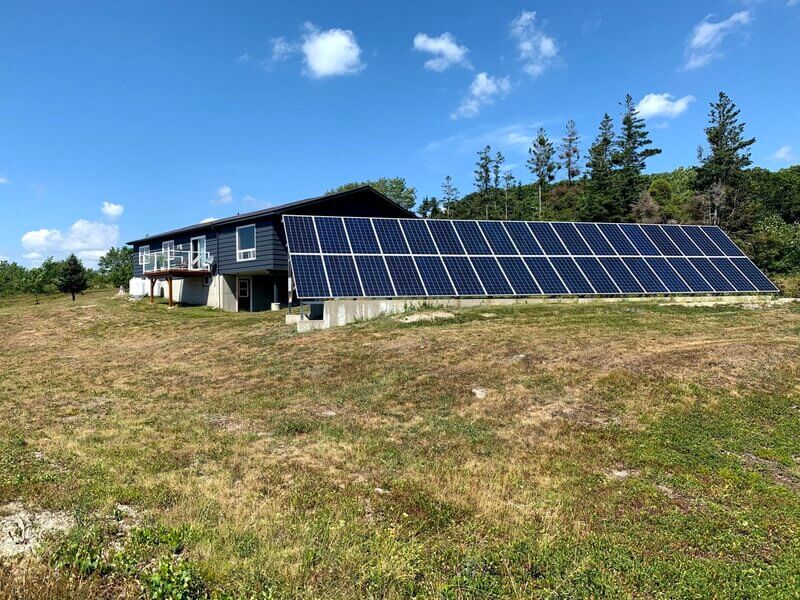
Wind Power
Wind power is another common and reliable source of renewable energy for off grid homes. Wind power works by turning the kinetic energy of the wind into electricity using wind turbines. Wind power is great for windy and open areas, and can provide a steady and consistent power supply. But, wind power also has some drawbacks, like the noise, the visual impact, the need for towers and foundations, the dependence on wind speed and direction, and the maintenance and repair of the turbines.
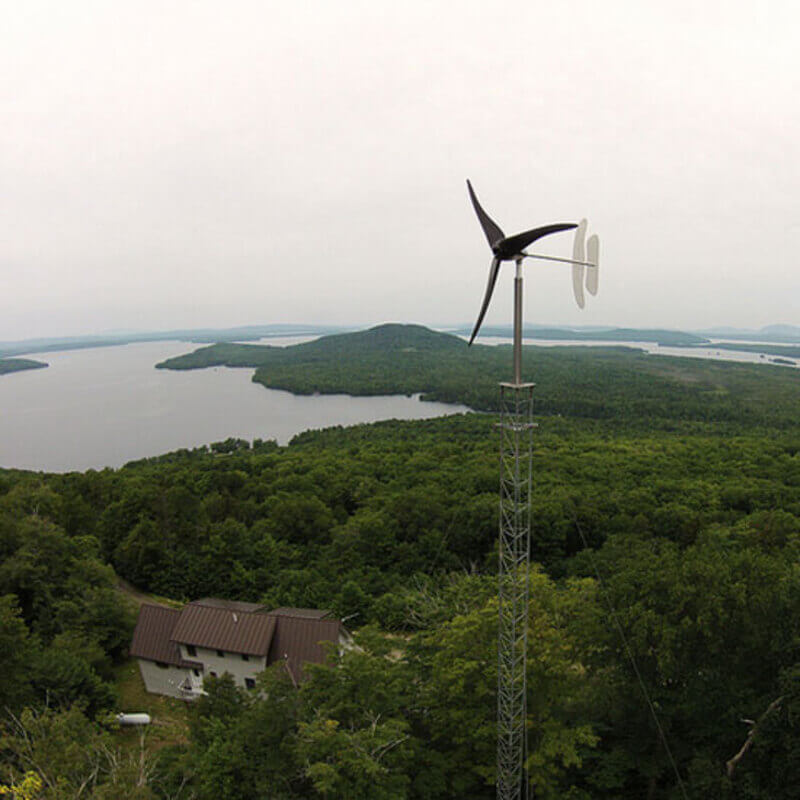
Hydro Power
Hydro power is a less common but very effective source of renewable energy for off grid homes. Hydro power works by turning the potential energy of flowing water into electricity using water turbines. Hydro power is great for areas with rivers, streams, or waterfalls, and can provide a continuous and stable power supply. But, hydro power also has some challenges, like the environmental impact, the need for permits and regulations, the dependence on water flow and level, and the maintenance and cleaning of the turbines and pipes.
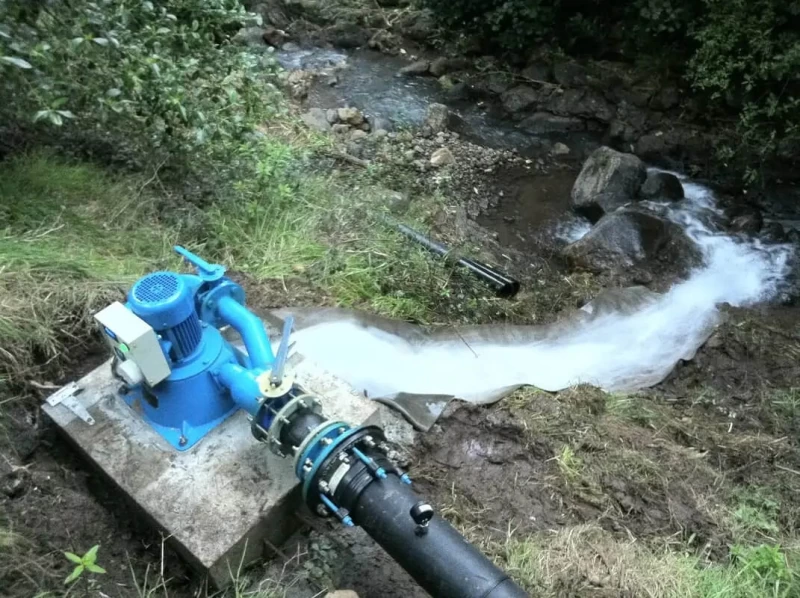
Biomass Power
Biomass power is a rare but viable source of renewable energy for off grid homes. Biomass power works by turning organic matter, like wood, crops, or animal waste, into electricity using generators or gasifiers. Biomass power is great for areas with abundant and cheap biomass resources, and can provide a flexible and versatile power supply. But, biomass power also has some drawbacks, like the emissions, the need for storage and transportation, the dependence on biomass availability and quality, and the maintenance and cleaning of the generators or gasifiers.
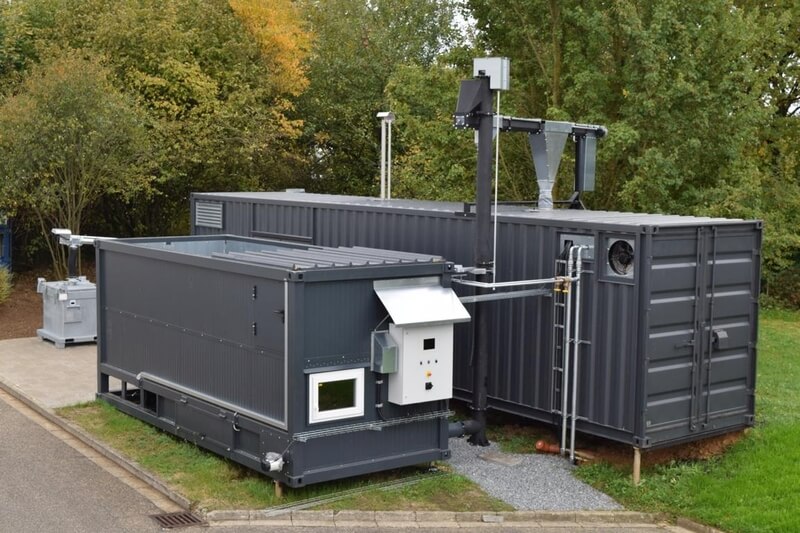
No matter which system you choose, you’ll need some safety components to make sure that your system works properly and safely. These components include:
- Charge controller: A charge controller is a device that controls the voltage and current from your renewable energy source to your battery bank. It stops overcharging, undercharging, and reverse charging, and extends the life of your batteries. This is the set up we have in our loft.
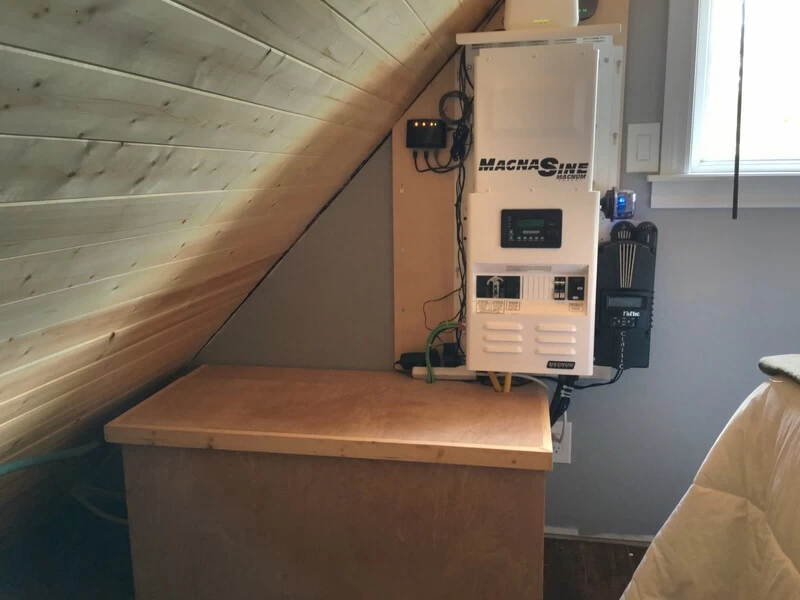
- Battery bank: A battery bank is a bunch of batteries that store the extra electricity from your renewable energy source for later use. It provides backup power when your renewable energy source is not available, and lets you use AC appliances that need more power than your renewable energy source can provide. You’ll need to choose the right type, size, and number of batteries for your system, and keep them in a well-ventilated, dry, and secure place. We have AGM batteries which do not off gas so they can be kept inside this rather handy wooden box that also serves as a seat.
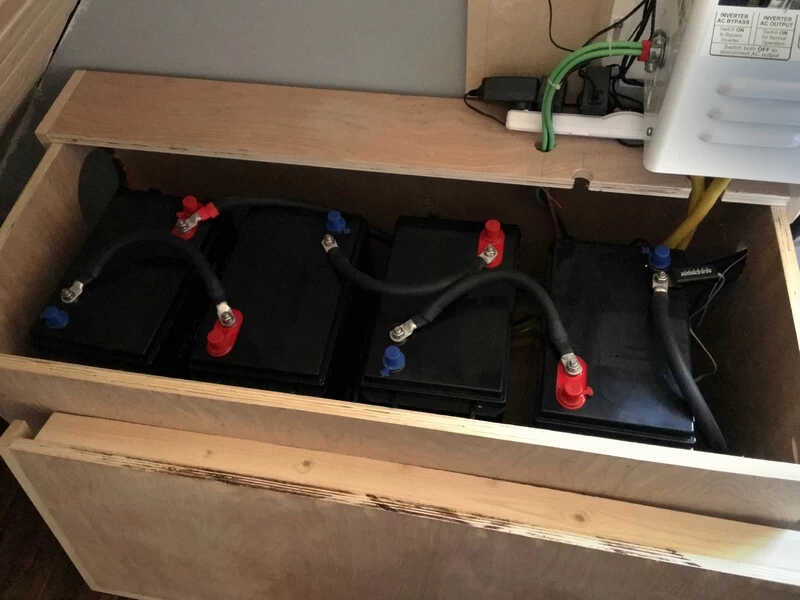
- Inverter: An inverter is a device that changes the DC electricity from your renewable energy source or battery bank into AC electricity that most of your appliances use. It lets you use standard appliances and devices in your off grid home, and protects them from power surges and fluctuations. You’ll need to choose the right type, size, and number of inverters for your system, and keep them in a cool, dry, and accessible place.
Be sure to bookmark our Harnessing the Sun: A Beginner’s Guide to Off-Grid Solar Systems
How to Get Water for Your Off Grid Home
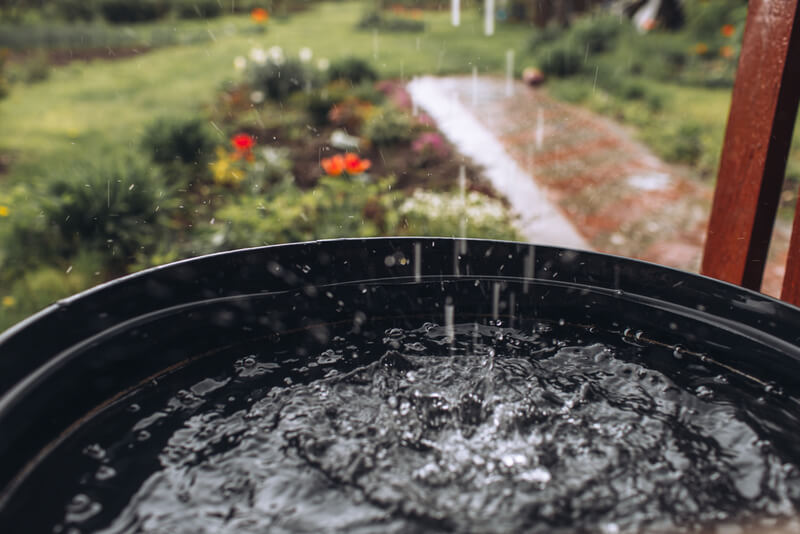
Another essential thing about off grid living is how to get water for your off grid home. Without water, you can’t drink, cook, clean, wash, and grow your food. Water is also vital for your health and hygiene, and can affect the quality of your life.
Luckily, there are many options for getting your own water from natural sources, like rain, wells, springs, and rivers. These sources are free, abundant, and renewable, and can help you conserve water and reduce your water bills.
But, getting water for your off grid home can also be tricky, as there are many things to think about, like your location, climate, water needs, budget, and preferences. Here are some of the common sources of water for off grid homes, and how to use them safely and efficiently:
Rainwater
Rainwater is one of the most simple and accessible sources of water for off grid homes. Harvesting rainwater works by collecting and storing the rain that falls on your roof or other surfaces using gutters, pipes, tanks, and barrels. Rainwater is great for areas with high rainfall and low pollution, and can provide enough water for most of your needs. But, rainwater also has some downsides, like the variability, the contamination, the need for filtration and purification, and the maintenance and cleaning of the system.
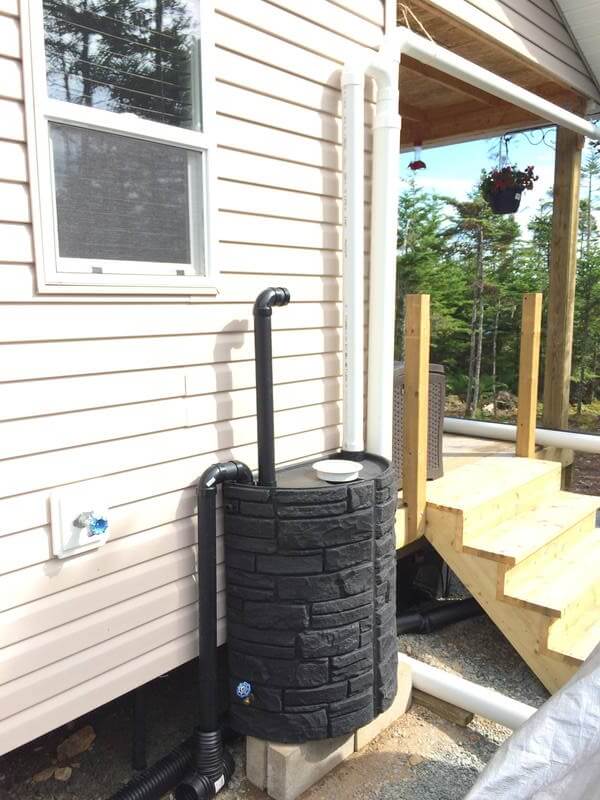
Well Water
Well water is another common and reliable source of water for off grid homes. Well water works by drilling or digging a hole in the ground and pumping the water from the underground aquifer using a pump, a pipe, and a pressure tank. Well water is great for areas with high water table and good water quality, and can provide a steady and consistent water supply. But, well water also has some drawbacks, like the high initial cost, the need for permits and regulations, the dependence on water level and quality, and the maintenance and repair of the system.
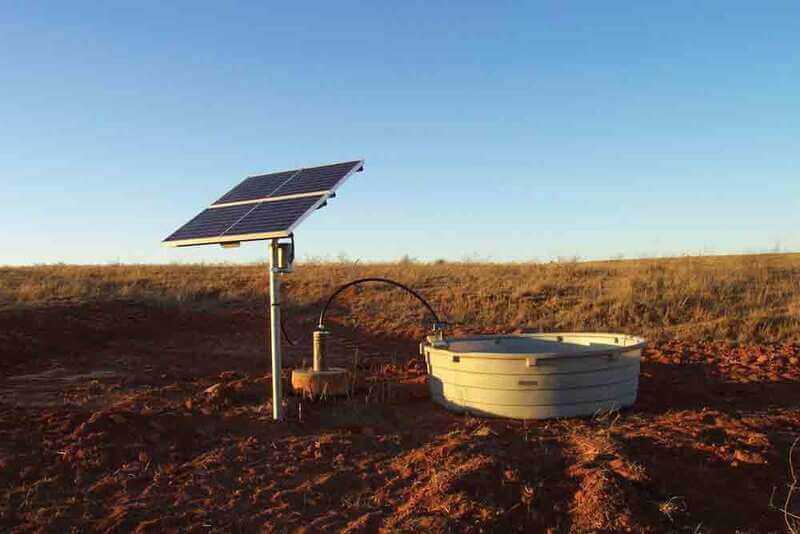
Spring Water
Spring water is a less common but very pure source of water for off grid homes. Spring water works by tapping into a natural spring that flows from the ground and transporting the water to your home using a pipe, a valve, and a storage tank. Spring water is great for areas with clean and abundant springs, and can provide a high-quality and constant water supply. But, spring water also has some challenges, like the environmental impact, the need for permits and regulations, the dependence on spring flow and quality, and the maintenance and cleaning of the system.
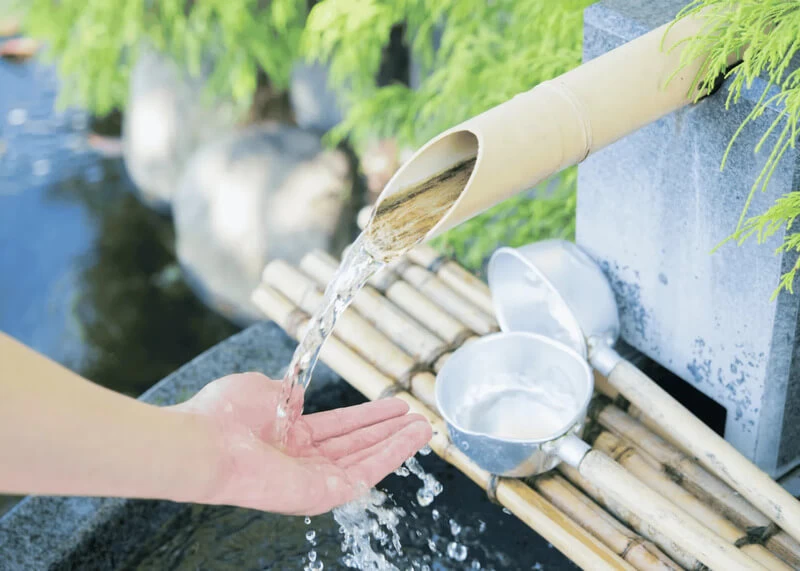
River Water
River water is a rare but feasible source of water for off grid homes. River water works by diverting a part of the river water to your home using a pump, a pipe, and a storage tank. River water is great for areas with large and fast-flowing rivers, and can provide a sufficient and renewable water supply. But, river water also has some drawbacks, like the contamination, the need for filtration and purification, the dependence on river level and quality, and the maintenance and repair of the system.
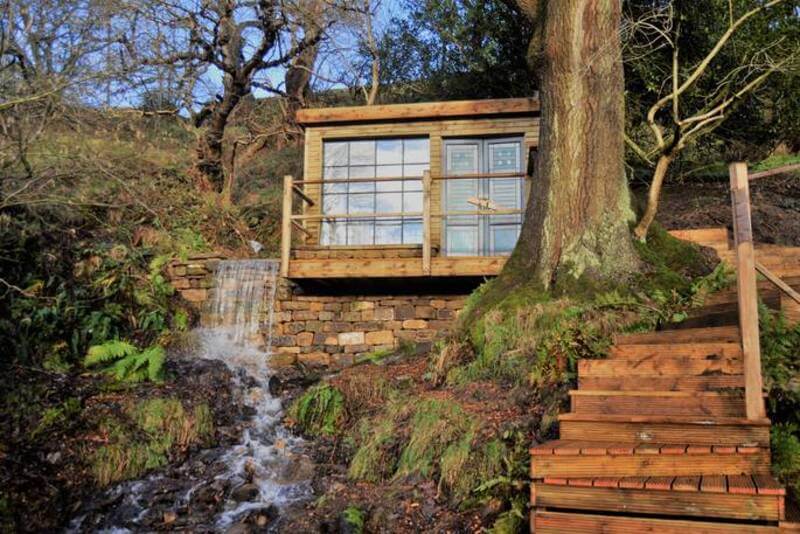
No matter which source you choose, you’ll need some safety components to make sure that your water is safe and healthy for your consumption and use. These components include:
- Filtration system: A filtration system is a device that removes the physical impurities, like dirt, sand, and debris, from your water. It improves the clarity, taste, and odor of your water, and protects your appliances and pipes from clogging and damage. You’ll need to choose the right type, size, and number of filters for your system, and replace them regularly.
- Purification system: A purification system is a device that removes the biological and chemical contaminants, like bacteria, viruses, and pesticides, from your water. It ensures the safety and health of your water, and prevents diseases and infections. You’ll need to choose the right type, size, and number of purifiers for your system, and maintain them properly. Some of the common types of purifiers are boiling, chlorination, ultraviolet, and reverse osmosis.
- Water heater: A water heater is a device that heats your water to a desired temperature for your comfort and convenience. It lets you enjoy hot water for your shower, bath, laundry, and dishes. You’ll need to choose the right type, size, and number of water heaters for your system, and keep them in a well-insulated, ventilated, and secure place. Some of the common types of water heaters are electric, gas, solar, and wood.
Check out our How to Harvest RainWater for Off Grid Living: A Step-by-Step Guide where we talk about designing and building a rainwater harvesting system.
And for heating that collected rain water you’ll want a nice hot shower and tap water. Here’s our article about How I Installed a Tankless Water Heater for My Off Grid Cabin.
How to Manage Waste for Your Off Grid Home
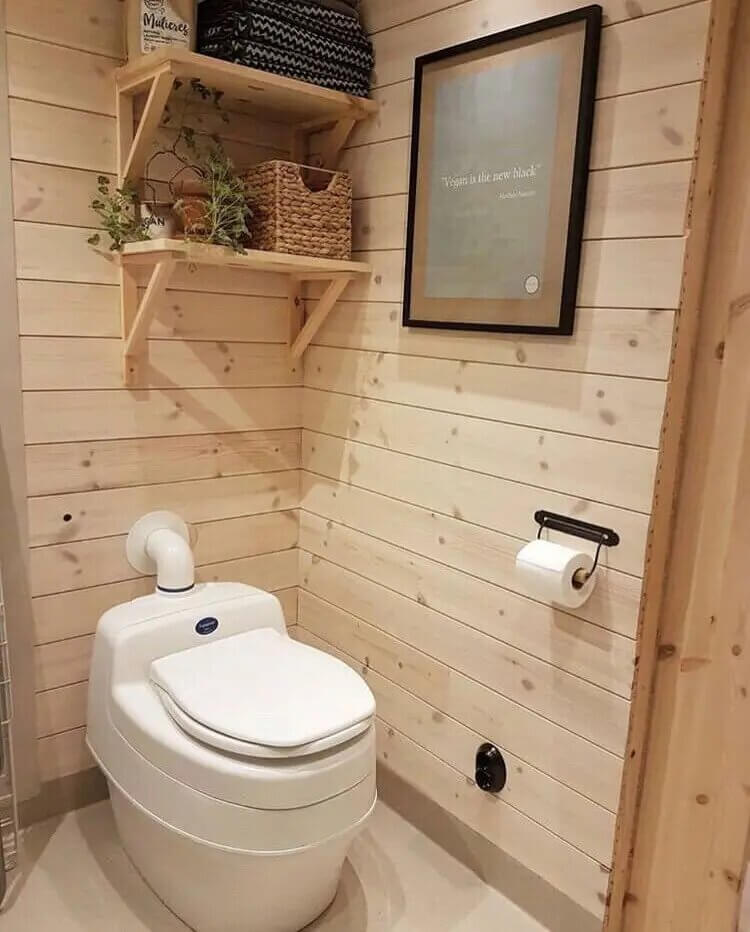
Another important thing about off grid living is how to manage waste for your off grid home. Without proper waste management, you’ll face problems like odor, pests, pollution, and health hazards. Waste management is also important for your environmental responsibility, as it reduces your waste generation and disposal, and recycles your waste into useful resources.
Luckily, there are many options for managing your own waste in an eco-friendly and efficient way, like composting, recycling, and reusing. These options are cheap, simple, and rewarding, and can help you improve your soil, garden, and home.
But, managing waste for your off grid home can also be tricky, as there are many things to think about, like your location, climate, waste needs, budget, and preferences. Here are some of the common methods of waste management for off grid homes, and how to use them safely and efficiently:
Composting
Composting is one of the most popular and beneficial methods of waste management for off grid homes. Composting works by breaking down your organic waste, like food scraps, yard trimmings, and paper, into a rich and fertile soil amendment using microorganisms, air, and moisture. Composting is great for areas with enough space and suitable climate, and can provide you with a valuable and natural fertilizer for your plants and crops. But, composting also has some downsides, like the odor, the pests, the need for aeration and moisture, and the maintenance and turning of the pile.
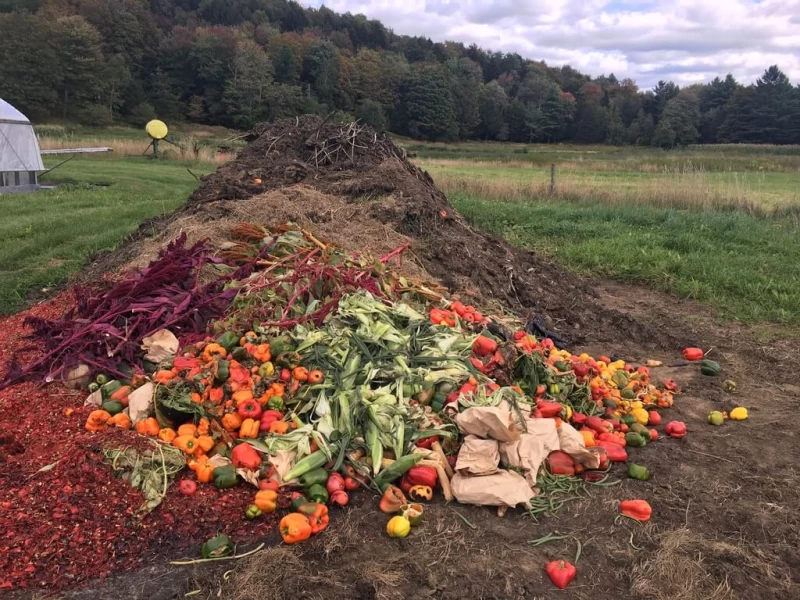
Recycling
Recycling is another common and responsible method of waste management for off grid homes. Recycling works by collecting and processing your non-organic waste, like plastic, metal, glass, and cardboard, into new and useful products using machines, chemicals, and energy. Recycling is great for areas with access to recycling facilities and programs, and can help you reduce your waste generation and disposal, and save money and resources. But, recycling also has some drawbacks, like the contamination, the need for sorting and cleaning, the dependence on market demand and supply, and the transportation and emission of the waste.
Reusing
Reusing is a less common but very creative method of waste management for off grid homes. Reusing works by finding new and alternative uses for your old and unwanted items, like clothes, furniture, and appliances, instead of throwing them away. Reusing is great for areas with limited resources and options, and can help you improve your home, garden, and lifestyle, and express your personality and style. But, reusing also has some challenges, like the clutter, the need for repair and modification, the dependence on your skills and imagination, and the maintenance and cleaning of the items.
No matter which method you choose, you’ll need some safety components to make sure that your waste management is hygienic and sanitary for your home and environment. These components include:
- Compost toilet: A compost toilet is a device that collects and composts your human waste, like urine and feces, into a harmless and odorless soil-like material using microorganisms, air, and moisture. It eliminates the need for water, sewerage, and chemicals, and reduces your water consumption and pollution. You’ll need to choose the right type, size, and number of compost toilets for your home, and keep them in a well-ventilated, dry, and secure place. You’ll also need to add some bulking materials, like sawdust, peat moss, or straw, to your compost toilet, and empty and use the compost when it is ready.
- Separate composting and trash bins: Always keep compostable and non-compostable items separate. Non-compostable and non-recyclable waste, like diapers, batteries, and medical waste, should be kept in a separate trach bin until you dispose of them properly. Compost everything else as soon as possible when living off grid as it prevents the spread of odor, pests, and diseases, and protects your home and environment from contamination. You’ll need to choose the right type, size, and number of trash bins for your home, and keep them in a well-covered, sealed, and if kept outside in a secure place.
- Worm bin: A worm bin is a device that converts your organic waste, like food scraps, paper, and cardboard, into a nutrient-rich and organic fertilizer using worms, microorganisms, air, and moisture. It enhances the quality and quantity of your compost, and provides you with a natural and effective pest control for your plants and crops. You’ll need to choose the right type, size, and number of worm bins for your home, and keep them in a well-shaded, moist, and secure place. You’ll also need to add some bedding materials, like shredded newspaper, coconut coir, or leaves, to your worm bin, and harvest and use the worm castings and worm tea when they are ready.
If you’re curious as to how our off grid toilet system works then check out our composting toilet post Off Grid Toilet A Comprehensive Guide.
How to Stay Connected and Secure in Your Off Grid Home
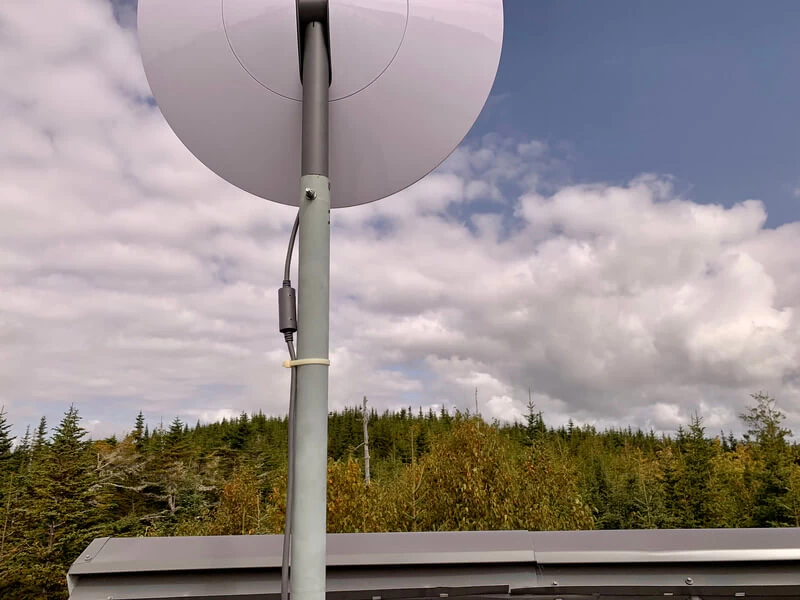
Another important thing about off grid living is how to stay connected and secure in your off grid home. Without connection and security, you’ll feel isolated, bored, and vulnerable in your off grid home. Connection and security are also important for your social and emotional well-being, as they let you communicate, entertain, and protect yourself and your loved ones.
Luckily, there are many options for staying connected and secure in an off grid home. Just because you’re not tied to the grid doesn’t mean you can’t have access to a smartphone, tablet, and even a TV. There are off grid specific options that are more convenient and affordable than others. It depends on your location and what’s available in your area. Best of all with access to these devices you have the reassurance of staying informed, access information, entertainment, and emergency services.
But, staying connected and secure in your off grid home can also be tricky, as there are many things to think about, like your location, climate, connection and security needs, budget, and personal preferences. Here are some of the common ways of staying connected and secure in your off grid home, and how to use them safely and efficiently:
Internet
High speed internet has become almost a necessity. It allows for services like banking, communication, and entertainment. The internet has become a common form of staying connected to others while being able to provide security in your off grid home. We have the Starlink satellite system and it has been by far the best method to access the internet for our location. We used to use a wifi hub with a cellular sim card but the signal was so weak in our area and our data was capped to a specified amount each month. Starlink has unlimited high speed data regardless of the weather outside. The satellite internet is great for areas with access to internet service providers and signals, and can provide you with unlimited information, entertainment, communication and security. But, off grid internet also has its downsides, like the high initial cost for hardware, a monthly recurring charge for the service, the need for multiple devices and power usage, the dependence on signal and speed, and the maintenance and repair of the system.
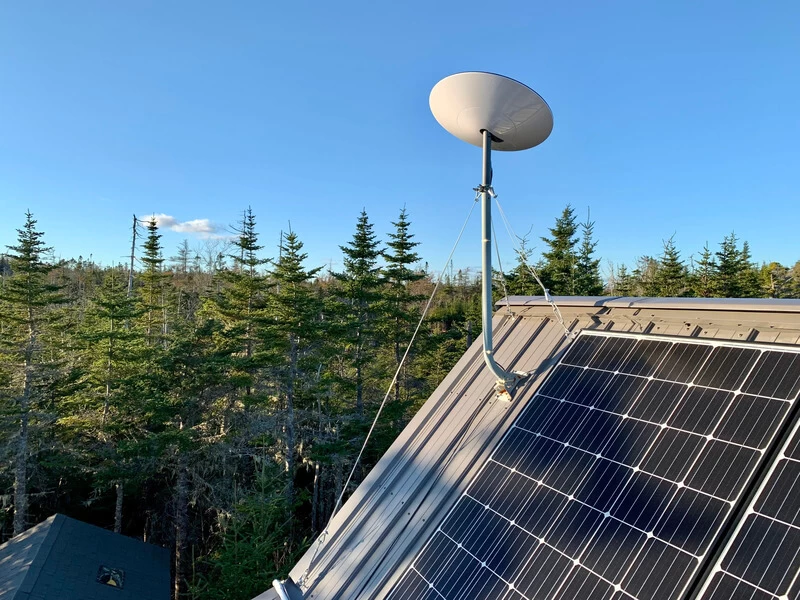
Smartphone
A smartphone is another common and reliable way of staying connected and secure in your off grid home. Depending on your location you may or may not have access to a high speed cellular network or data access. A nearby tower and a strong connection are a necessity if you want to utilize your phone as a wifi hotspot in order to share your cellular data with other devices. A smartphone can be critical in providing you with instant communication, emergency services, and social connection to friends and family. But, like the satellite internet it also has some drawbacks, like the high cost of cellular data (at least in our area), the need to recharge using your generated power, plus the dependence on signal and coverage.

Radio
A household radio is still a common item and especially with folks off grid. We always have a solar powered crank weather radio at the cabin. It requires little power and can be a very useful way of staying connected to the world outside your off grid home. Radios work in almost all climates and locations. It is a simple and proven system that’s been around for over one hundred years now. Your local radio tower sends radio waves over its network in various frequencies, like AM, FM, or CB for two-way communication. It’s great for areas without a cellular service provider and can provide you with local news, weather, and music. While the radio isn’t as glamorous as high speed internet, it does still have its drawbacks such as the limited selection of content, still requires power, and the dependence on a clear signal.
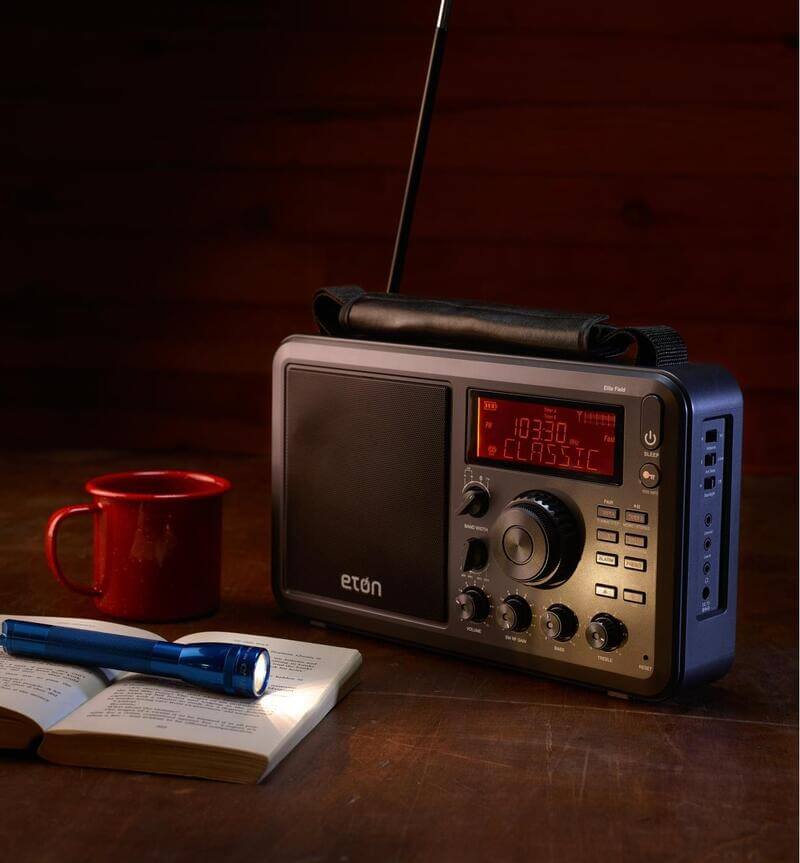
TV
There’s no reason you still cannot enjoy your favorite movies, TV shows and even live content while off the grid. While most TV works through a cable provider you can still access some local stations using an Over The Air antenna. If you have access to the internet using a satellite service like Starlink or over a cable TV specific provider you’ll have access to all your regular programming. While the biggest drawback to a TV is the power consumption, we’ve dealt with that by utilizing a mini-projector, an Amazon firestick, and our Starlink internet.
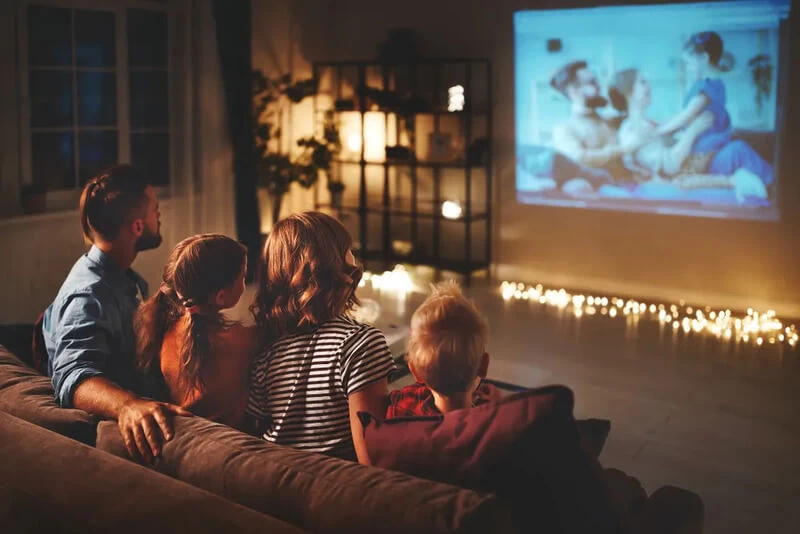
No matter which way you choose, you’ll need some safety components to make sure that your connection and security are reliable and safe in an off grid environment. These components might include:
- Surge protector: A surge protector is a device that protects your devices and systems from power surges and fluctuations that can damage or destroy them. It controls the voltage and current from your power source to your devices and systems, and prevents overloading, overheating, and short-circuiting. You’ll need to choose the right type, size, and number of surge protectors for your home, and keep them in a well-grounded, dry, and accessible place. Some solar systems have an incorporated sure protector.
- Fire extinguisher: A fire extinguisher is a must! A fire can break out in your home due to various causes, like faulty wiring, overheating, or sparks from a wood stove. You’ll need to choose the right type, size, and number of fire extinguishers for your off grid home, and keep them in a well-visible, reachable, and secure place. You’ll also need to check and recharge your fire extinguishers regularly, and use them properly and safely.
- Alarm system: An alarm system is a device that warns you and others of any potential threats or dangers in your home, like intruders, animals, or natural disasters. It may consist of a control panel, sensors, sirens, and cameras that can detect, record, and notify any unusual or suspicious activities in your home. Some security systems like ours are a complete all in one unit that is accessed and controlled through the internet via a smartphone app. They are solar powered, do not require a base station unit that continuously draws power, have a spot light and even artificial intelligence that detects people and not wildlife! You’ll need to choose the right type, size, and number of alarm systems for your home, and keep them in a well-powered, connected, and secure place. You’ll also need to test and update your alarm systems regularly, and activate and deactivate them as needed.
We discuss our complete off grid security setup in our article The Top Off Grid Living Myths Debunked.
Conclusion
Off grid living is a lifestyle choice that means living without relying on public utilities like electricity, water, gas, or sewerage. Instead, you use alternative sources of power, water, and waste management, like solar panels, rain barrels, compost toilets, and generators.
People choose off grid living for different reasons, like environmental concerns, self-reliance, cost savings, or personal preference. Off grid living can also vary in degree, from completely disconnected to partially connected to the grid.
In this article, we’ve given you a complete guide for beginners who want to learn more about off grid living. We’ve covered the following topics:
- How to power your off grid home
- How to get water for your off grid home
- How to manage waste for your off grid home
- How to stay connected and secure in your off grid home
We hope that this article has helped you to understand more about off grid living, and how you can start your own off grid journey. Off grid living can be a rewarding and fulfilling experience, as it lets you live a simpler, greener, and more independent life.
But, off grid living can also be a challenging and demanding experience, as it requires a lot of planning, preparation, and maintenance. Off grid living is not for everyone, and it is not a one-size-fits-all solution. You’ll need to consider your own needs, preferences, and circumstances, and find the best option for you.
If you’re interested in off grid living, we encourage you to do more research, learn from others, and take action. There are many resources, communities, and opportunities available for you to explore and pursue your off grid dreams.
Here are some tips and resources for further learning and action:
- The top off grid living myths debunked.
- The top 5 off grid living books that will inspire your off-grid dream.
- Watch more videos, documentaries, and shows on off grid living, like How to build a log cabin alone in Alaska with Dick Proenneke.
- Join our Facebook community
- Visit more places, events, and workshops on off grid living, like [Off Grid Expo], [Off Grid Festival], and [Off Grid Academy].
- Try more projects, experiments, and challenges on off grid living, like [Off Grid Solar Power Kit], [How To Ferment Anything: A Beginner’s Guide], and [How To Score The Top 10 Living Essentials Online].
We’d love to hear your thoughts and experiences on off grid living. Please feel free to share your comments, questions, and feedback with us. Thank you for reading this article, and we wish you all the best in your off grid adventure. 😊
Off Grid Living FAQs
- What are some of the legal issues of off grid living?
- Some of the legal issues of off grid living are zoning laws, building codes, permits, taxes, and regulations. These laws and rules vary depending on where you live, what kind of property you have, and what kind of system you use, and can affect your rights and responsibilities as an off gridder. You’ll need to research and comply with the relevant laws and rules for your area, and talk to a lawyer or an expert if needed.
- How much does it cost to live off grid?
- The cost of living off grid depends on many things, like where you live, what kind of property you have, what kind of system you use, what kind of lifestyle you have, and what kind of preferences you have. The initial cost of setting up your off grid home can be high, as you’ll need to buy or build your property, and install your system. But, the ongoing cost of living off grid can be low, as you’ll save money on utility bills, taxes, and maintenance. You’ll also need to consider the hidden costs of living off grid, like transportation, insurance, and emergency services. You’ll need to budget and plan your finances carefully, and find ways to cut your costs and boost your income.
- What are some of the skills and tools that I need to live off grid?
- Some of the skills and tools that you need to live off grid are DIY, gardening, cooking, preserving, repairing, and survival. These skills and tools will help you to build, maintain, and improve your off grid home, and to grow, prepare, and store your food. You’ll also need to learn and practice some basic first aid, fire safety, and self-defense skills and tools, in case of any emergencies or accidents. You’ll need to get and master these skills and tools gradually, and ask for help and advice from others when needed.
- How can I find and buy an off grid property?
- There are many ways to find and buy an off grid property, like online, offline, or word-of-mouth. You can look for off grid properties on websites, like [Off Grid Homes], [Off Grid Real Estate], and [Off Grid Property Finder]. You can also look for off grid properties in newspapers, magazines, or flyers, or ask around your friends, family, or neighbors. You’ll need to compare and evaluate the different options, and consider the location, size, price, and condition of the property. You’ll also need to inspect and test the property, and negotiate and finalize the deal with the seller.
- How can I make money while living off grid?
- There are many ways to make money while living off grid, like online, offline, or bartering. You can make money online by working remotely, freelancing, blogging, or selling your products or services on websites, like [Upwork], [Fiverr], [Etsy], and [Amazon]. You can also make money offline by working locally, farming, crafting, or offering your skills or services to your community. You can also barter your goods or services with other off gridders, in exchange for their goods or services. You’ll need to find and pursue the best opportunities for you, and balance your work and life.
This is the end of the article on off grid living. I hope you have enjoyed reading it, and learned something new and useful from it.
If you have any questions, comments, or feedback on the article, please feel free to share them with me. I would love to hear your thoughts and opinions on off grid living.
Your Turn...
P.S. If you enjoyed this post about Off Grid Living: A Complete Guide for Beginners then why not share it.
Share This Story, Choose Your Platform!
It’s how we keep growing our off grid community here and lets us know we’re posting the right kind of info you’re looking for.
Here’s a special Pinterest PIN for all our Pinterest fans out there!
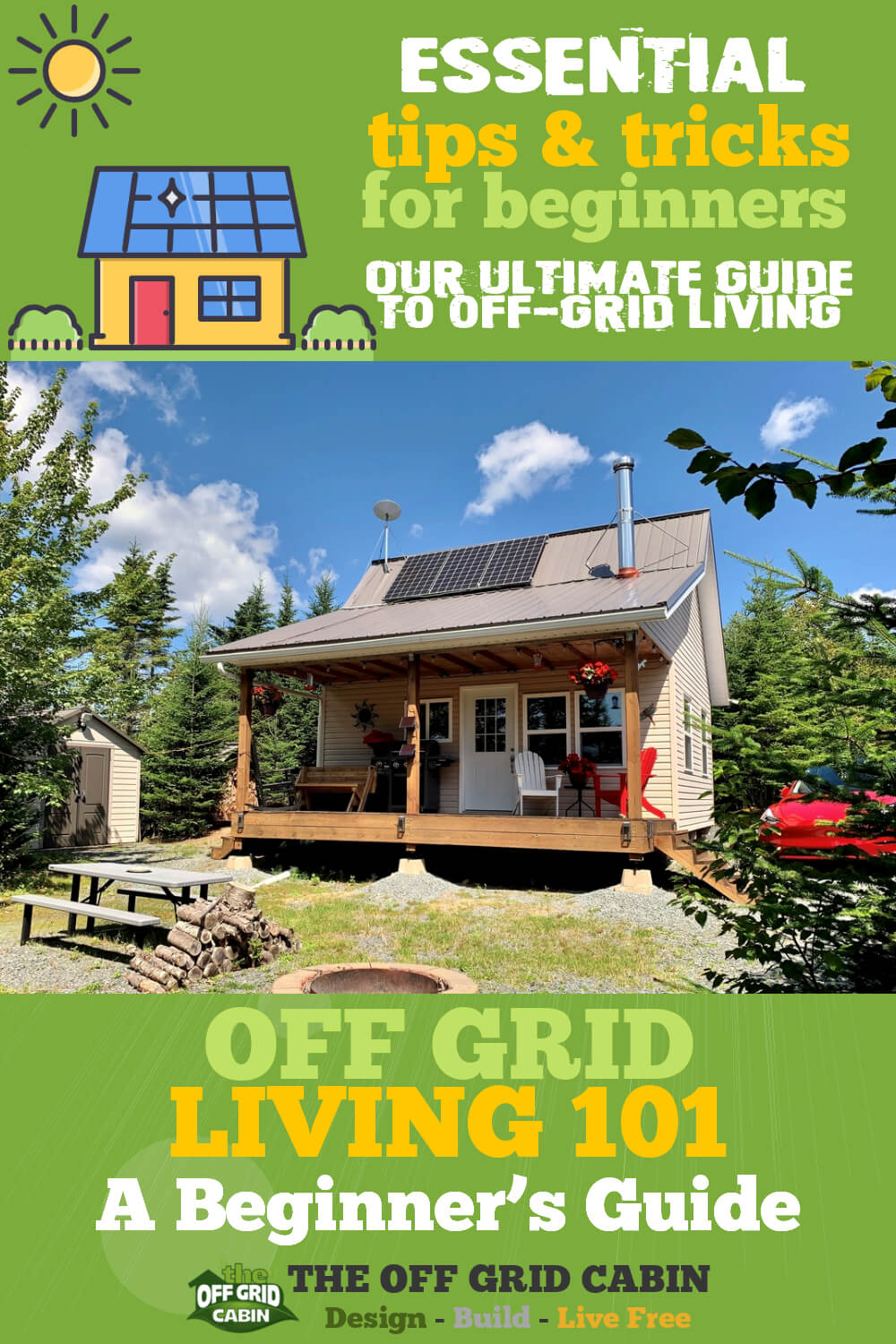
Let us know what you think in the comment section below.
And be sure to join the rest of the off grid community here and follow along with the build of our cabin!
We’ll update the Building The Cabin section every time we complete a new phase of the build so be sure to check in and watch the progression.
how to clean solar panels
How to Clean Solar Panels: A Step-by-Step DIY Guide As you already know, residential and off-grid solar systems are amazing sources of renewable energy that are quickly growing in popularity. The large flat [...]
earthship
What Is an Earthship and How It Can Help Save the Planet Imagine living in a home that is completely self-sufficient, eco-friendly, and comfortable. A home that grows its own food, collects its [...]
3-way-switch-wiring
3-Way Switch Wiring: A How to Comprehensive Guide Here at the off grid cabin we’ve done our fair share of electrical work including 3-way switch wiring. We’ve done all the internal and external [...]
solar generator
How To Find The Best Solar Generator Impact-Site-Verification: c336f89e-c692-4afd-99d9-0150f7329466 When we first cleared the land to build our off grid home back in 2016, we started with one of those small 700 watt [...]
Off Grid Heating
The Best Off Grid Heating Methods Introduction To Off Grid Heating If you're Living off the grid already or planning to in the future, you already know how important it is to have [...]
off grid appliances
The Best Off Grid Appliances for Off Grid Living Introduction To Off Grid Appliances Living off the grid can be a rewarding and fulfilling experience, but it also comes with some challenges. One [...]


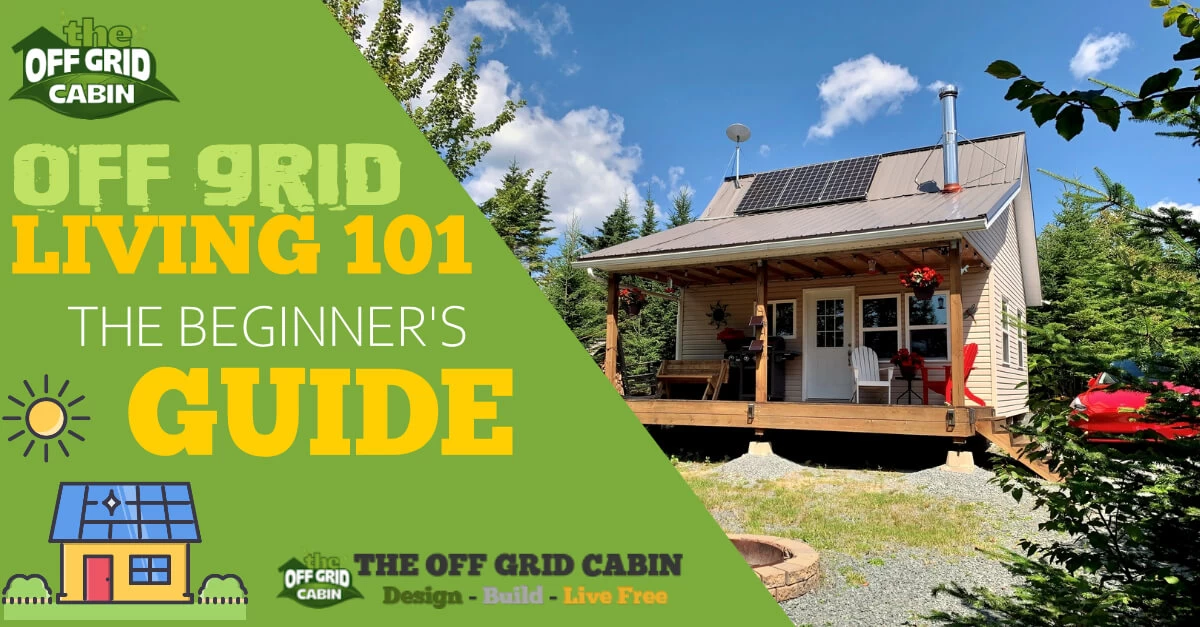
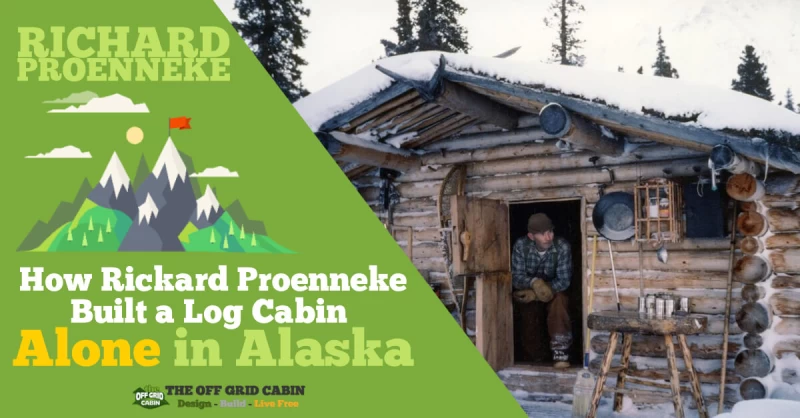
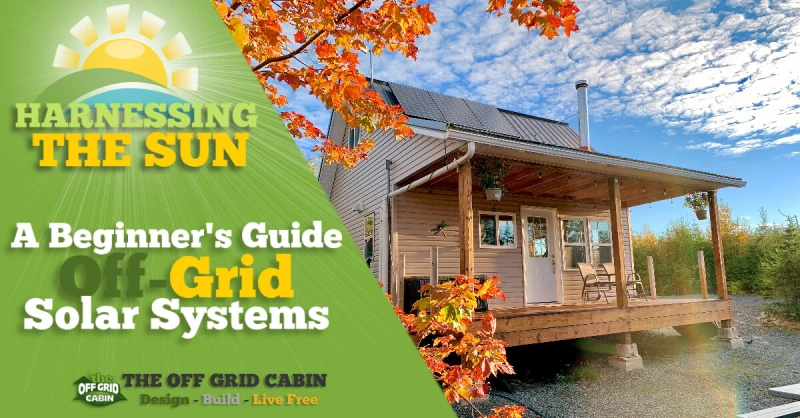
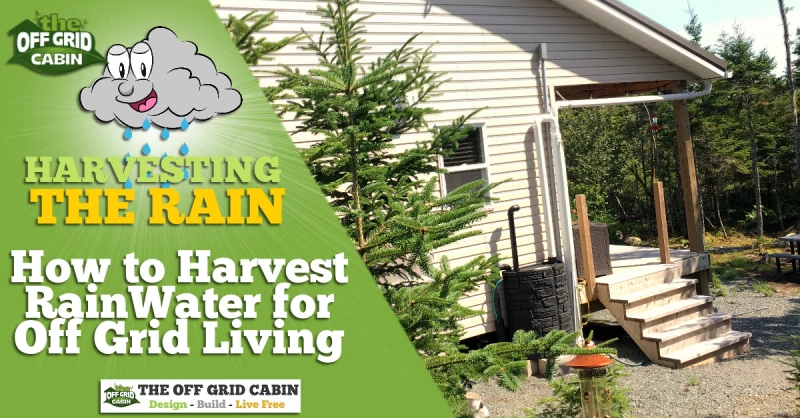
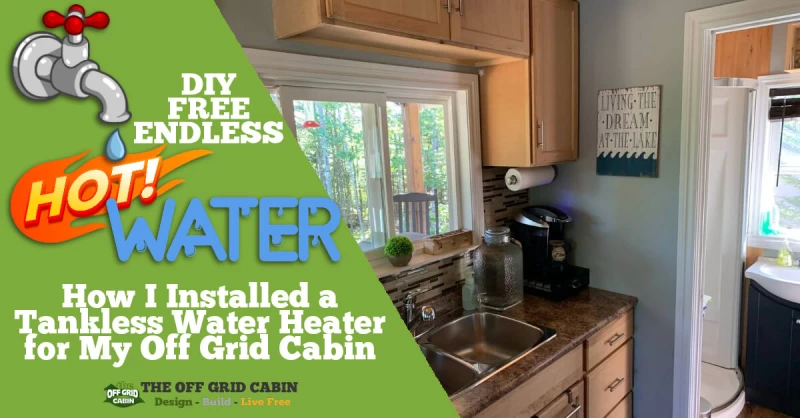
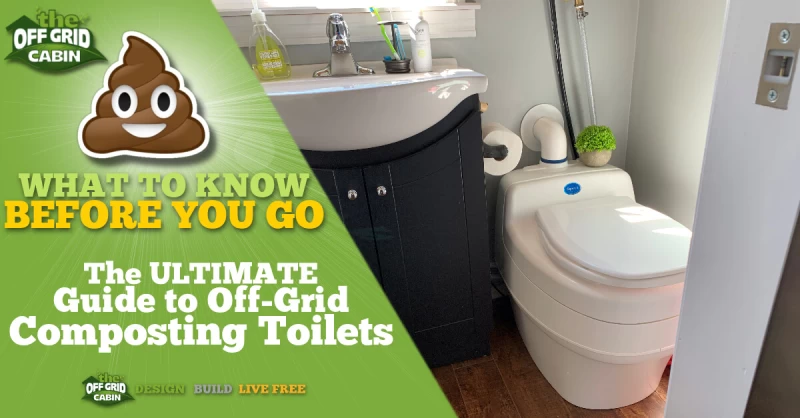
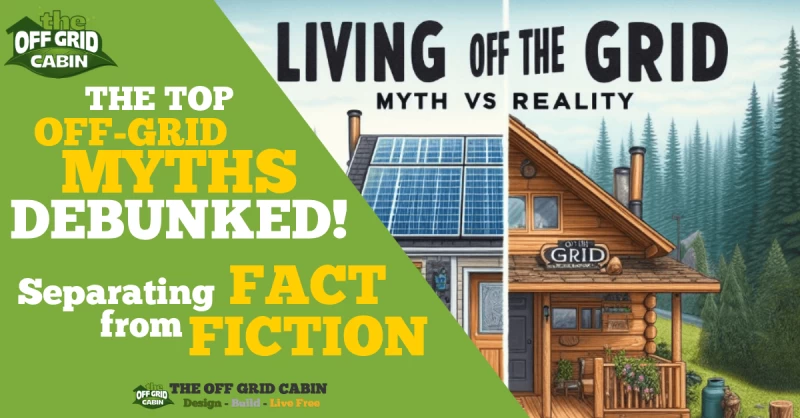
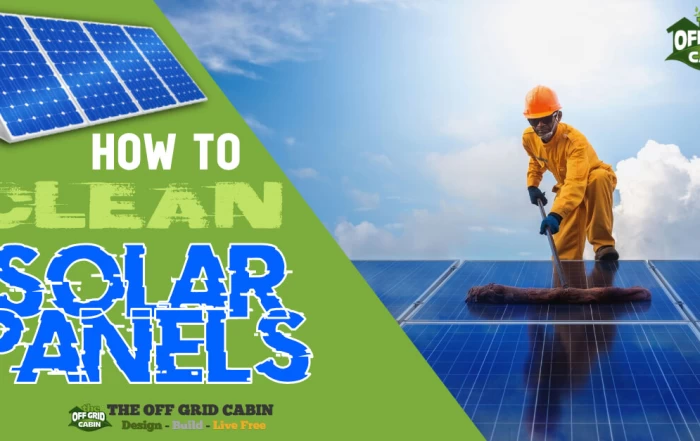
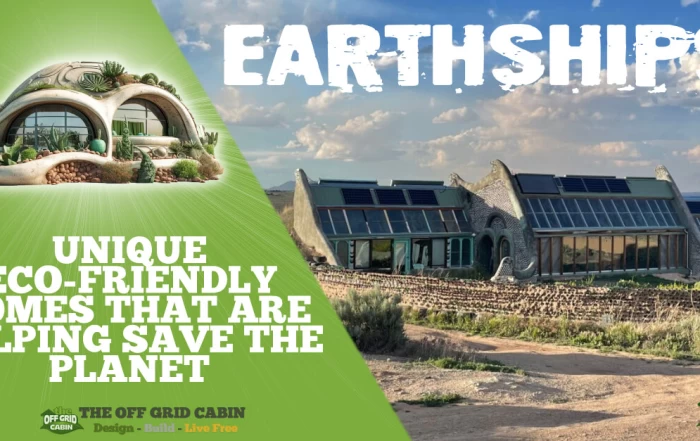
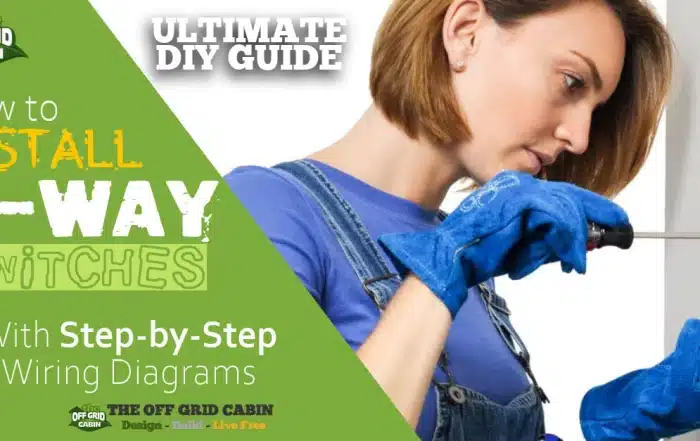
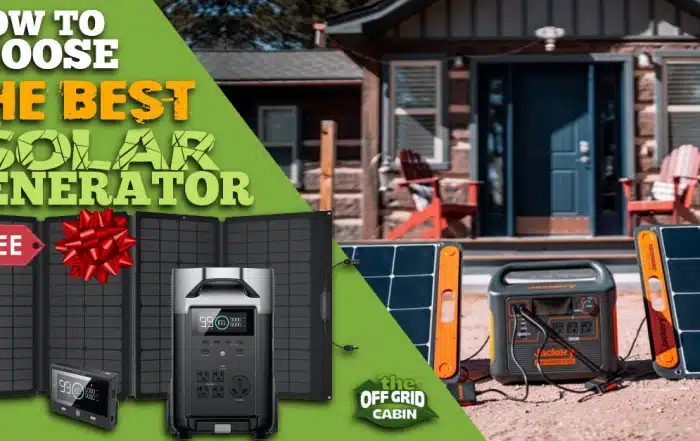
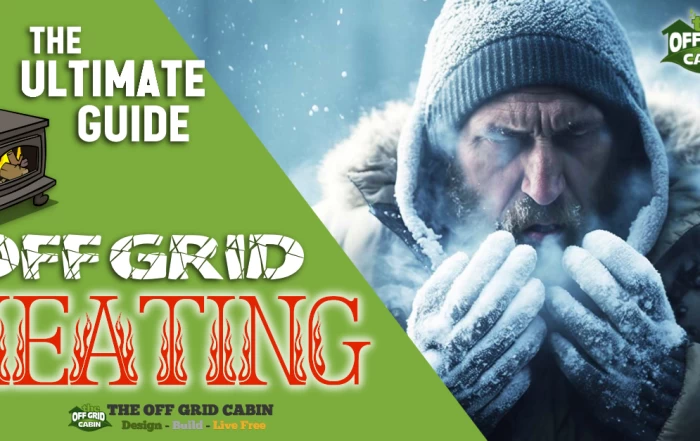
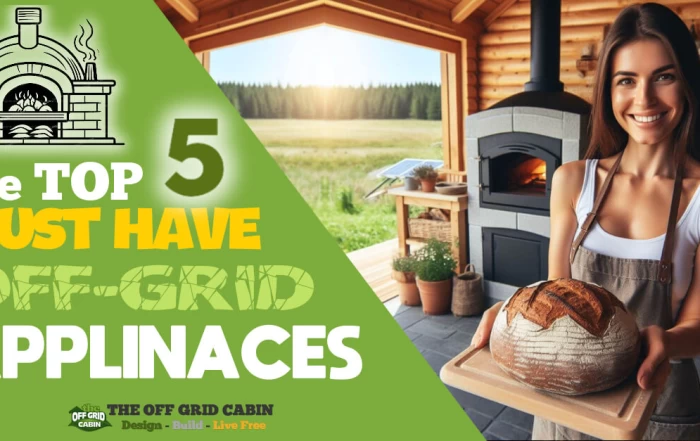
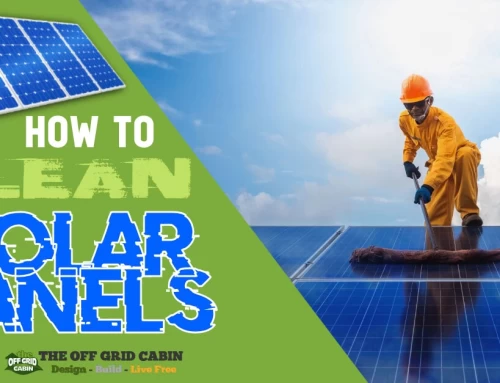
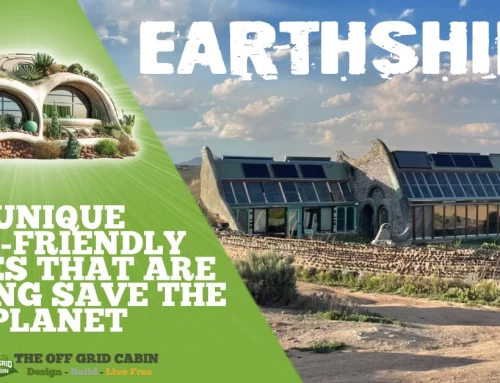

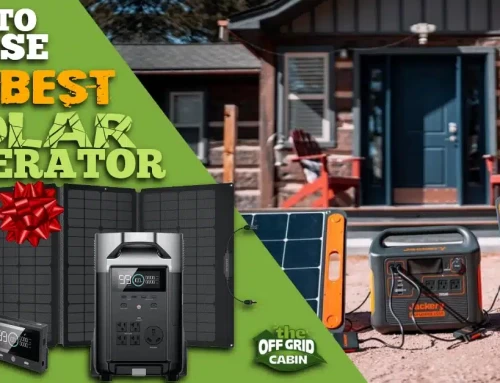
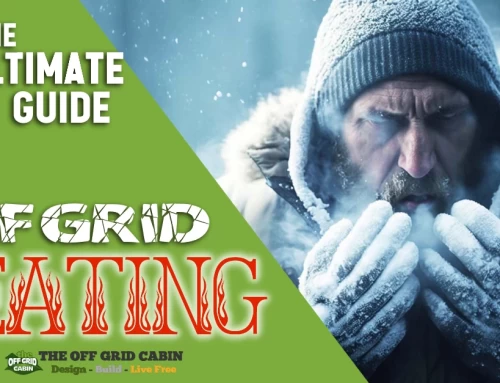
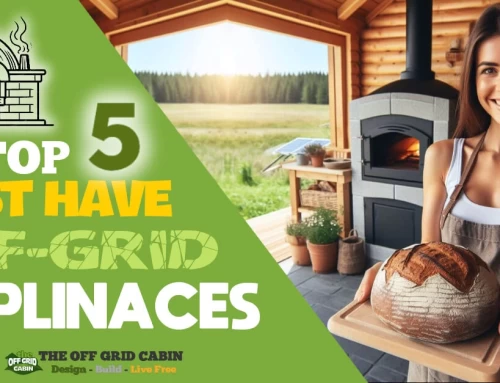
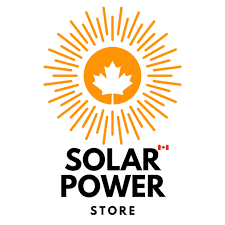
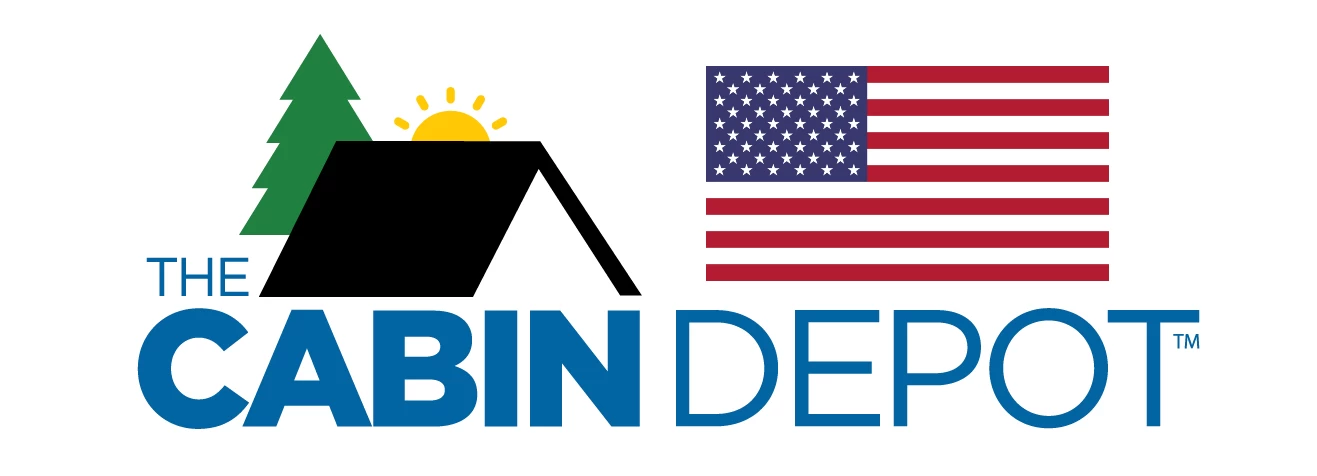
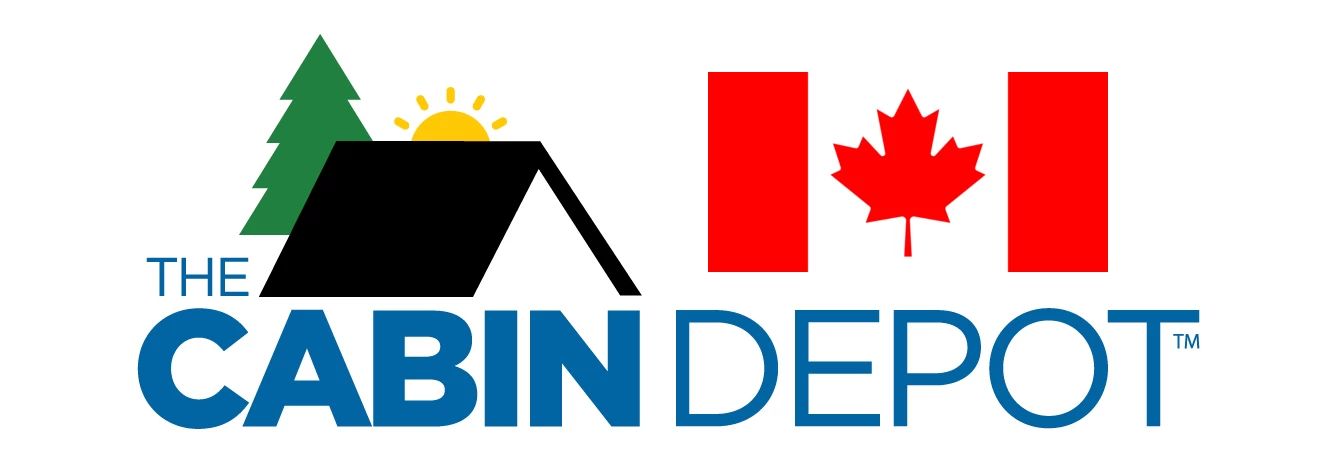
Leave A Comment